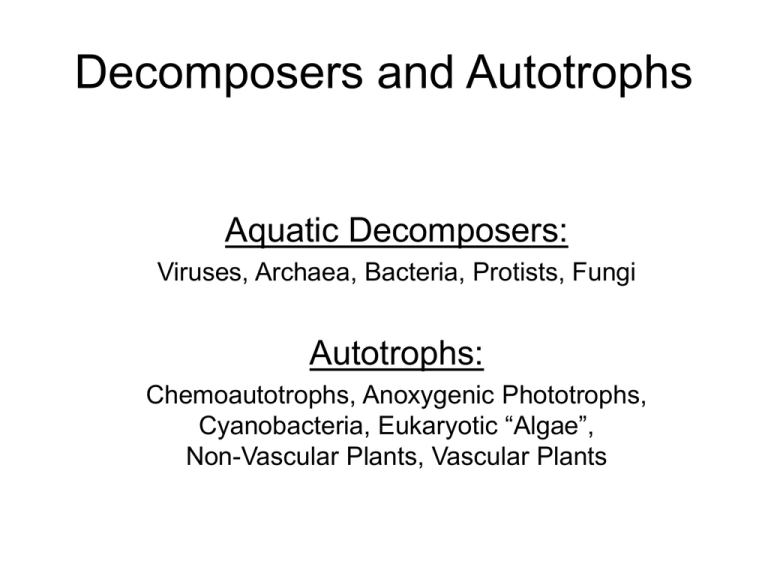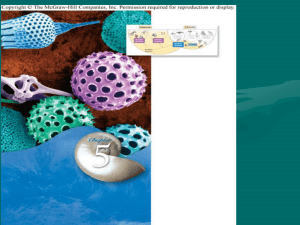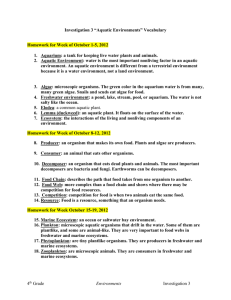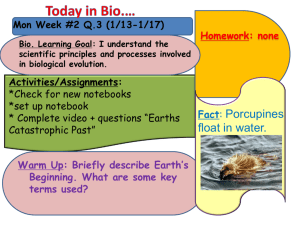Decomposers and Autotrophs
advertisement

Decomposers and Autotrophs Aquatic Decomposers: Viruses, Archaea, Bacteria, Protists, Fungi Autotrophs: Chemoautotrophs, Anoxygenic Phototrophs, Cyanobacteria, Eukaryotic “Algae”, Non-Vascular Plants, Vascular Plants Taxonomy of Cellular Life (Three Domains) Taxonomy: Phylogeny: Ecological Trophic Roles • Autotrophs (fix carbon dioxide into organic matter) – – – – Allochthonous (organic matter production from outside) Autochthonous (organic matter production within) Chemosynthesis (reduced inorganics as energy source) Photosynthesis (light as energy source) • Anoxygenic (Purple Sulfur and Green Sulfur bacteria; anaerobic) • Oxygenic (cyanobacteria and all eukaryotic algae and plants) – Some production lost from cells as DOM via exudation (leaking) • Decomposers (organic matter mineralized to P & N nutrients) – Microbial Heterotrophs: (major component of the “Microbial Loop”) • Prokaryotes and Fungi – mostly osmotrophs and some parasites – convert DOM or dead POM back to living cells and nutrients. • Protists (predators of prokaryotes; important link to main foodweb) • Overall, represents an important control of energy flow in the ecosystem. – Viruses (Facilitate DOM release by lysis of prokaryotes and algae.) – Detritivores (Consumers specialized in eating detritus.) • Consumers: – Grazers (primary consumers) – Predators (secondary and higher consumers) All interactions leak DOM; bacteria are important in this back to living cells (prey). Viruses: Archaea • Biochemically and phylogenetically distinct from Bacteria cells, with some characteristics more similar to Eukarya cells • Adapted to extreme environments (heat, acids, salts, anaerobic). • Methanogenesis is unique to archea; obligate anaerobes that respire using carbon dioxide to methane, an important “Greenhouse Gas”. • New archaea groups are being discovered from non-extreme environments; little is known ecologically or physiologically about these new discoveries. Methanococcus sp. Bacteria: • Extremely diverse; biomass greater than all other life combined. • Less than 1% of the bacteria species in the world have actually been described. Not all species can be cultivated and studied successfully with present techniques. Bacterial Distribution in Lakes Planktonic • Epilimnion density high; trophic activity and DOM release is greatest in euphotic zone (yellow line = light) • Hypolimnion density decreases (less DOM) and does not increase until immediately above the sediments. Benthic • Surface sediment density is about 1000times greater than surface water density, and decreases with depth, largely due to lack of oxygen. Heterotrophic Protists Protists are a polyphyletic group (many distinct evolutionary lineages). Includes many species also considered algae, or mixotrophs. Heterotrophs are important as predators of bacteria and as parasites. Includes familiar subphyla Sarcodina (which includes the Amoeba), Ciliophora (includes the ciliated Stentor), and zooflagellates. Oomycota and Fungi • Most fungi are saprophytic, decomposers of dead organic matter, very important in the breakdown of organic detritus from terrestrial sources. – Anamorphs (asexual forms) of Ascomycota and some Basidiomycota are most abundant on detritus (leaves, wood). – Along with bacteria, they increase the nutritional quality of detritus. – Some are very adapted for this role in aquatic environments (see example of amphibious fungi below • Some Oomycota and all Chytridiomycota are parasitic, killing their prey and decomposing the tissues. • Others form symbiotic associations with cyanobacteria or green algae called lichens. • Because of low amounts of organic matter, fungi not usually present in pristine groundwater. Amphibious Fungi Many taxa have tetraradiant conidia (asexual spores) via convergent evolution. Shape helps anchor them to leaf surfaces in stream flow. Colonization enriches CPOM for shredder amphipods, which are important to the fish diet. Parasitic Oomycota and Chytridiomycota A rotifer caught by one of the “lethal lollipops” of the oomycete, Zoophagus sp. Both a copepod (sexual; gametophyte host) and chironomid larvae (asexual; sporophyte host) are required for chydrid, Coelomomyces sp. Lichens Most common in wetlands; rare in lakes and rivers, never groundwater. foliose (leaf-like) crustose (encrusting a surface) fruticose (projections) Cyanobacteria • Distinguished from anoxygenic photosynthetic bacteria by presence of chlorophyll a (more evolutionarily advanced than bacteriochlorophyll of Purple and Green bacteria). • Oxygenic Photosynthesis, Well studied compared to other bacteria as they are large (1 μm to 100 μm) and have distinct morphologies (spherical, filamentous, and colonies) • Many can fix-N2 gas into ammonia for assimilation into cell biomass; thereby, never N-limited growth; only occurs in the absence of oxygen, such as in specialized cells called heterocysts. heterocyst • In filamentous forms, cells are arranged end-to-end to form trichomes which may be contained within a sheath. • Akinetes are like spores, or “resting” cells. They can develop while still attached to the filament. • Hormogonia are small fragments of the the parent trichome and move away to develop a new filament. Filaments and gelatinous forms are quite resistant to protist phagocytosis as illustrated in this video. • Gas vesicles give some cyanobacteria buoyancy, and when blooms occur these can form surface scums. Affords them an advantage in the competition for light at the surface. • Some produce noxious odors and toxins. • May accumulate high biomass in eutrophic waters, causing night time fish kills by depleting oxygen. • Cyanobacteria contain phycobillins, which are pigments that absorb light in the green region where chlorophyll does not absorb. Allows them to photosynthesize at greater depths than other organisms. Algae • An ecological grouping of Eukaryotic taxa that perform, oxygenic photosynthesis. • This is an extremely taxonomically and morphologically diverse group of organisms (unicellular, multicellular, immobile, motile, sessile, etc.) • Major taxonomic groups are distinguished by accessory photopigments. • Rhodophyceae (Red Algae) - Poorly represented in freshwater systems; none are planktonic. Mainly restricted to fast-moving streams of cool, well oxygenated water. Contain phycoerythrin (reflects red light, absorbs blue light). • Chrysophyceae (Golden-brown Algae) - Commonly found as planktonic in oligotrophic lakes; mostly unicellular (possessing flagellum), sometimes colonial. – Unicellular species very small; colonial species very large so it limits grazing by herbivores. – Some species of Dinobryon genus able to take up phosphate at very low ambient levels. Dinobryon Synura • Bacillariophyceae (Diatoms) – Extremely important algae group, both planktonic and benthic. – Possess a characteristic frustule, a clear glass-like cell wall. – Frustule is divided into halves; halves fit together in either a pennate (elongate) or centric (circular) form. – Centric forms = radial symmetry, pennate forms = bilateral symmetry – These can attach to form to hard substrate, and form filaments – Benthic diatoms of stream periphyton are an indicator of good water quality. • Diatoms are generally large and often not motile; they rely on slow sink rates, oil droplets and upwelling dynamics to stay in the surface layer. • The frustule is made of silicon and is not very soluble. Silica is a limiting nutrient to their growth. • Typically bloom in spring, fastest growth when there are plenty of N, P, and Si; during summer they are less abundant (grazed or sank). • When diatoms die, they sink to the bottom and the frustule is incorporated into the sediments. • Historic patterns of planktonic community structure can be studied in sediment cores containing diatom frustules. Isotopic composition of frustules can be used to date sediments, study past patterns of abiotic conditions. This is the field of paleolimnology. • Dinophyceae (Dinoflagellates) – Unicellular, motile, have flagella. – Many species develop an armor-like cell wall, which can be very elaborate in shape and even possess horn-like projections. – Some dinoflagellates produce toxins and are problematic when they experience blooms; Pfisteria commonly implicated in fish kills, and can harm humans. • Euglenophyceae (Euglenoids) – Unicellular, motile, some have flagella. – Many capable of both autotrophy and heterotrophy (phagotrophic) = mixotrophy. • Chlorophyceae (Green algae) – Diverse group, from unicellular to complex multicellular assemblages. – Found in all surface habitats (wetlands, damp soils, lake and river benthic zones, etc.) – Unicellular species most common as lake plankton. – Filamentous species usually epibenthic (e.g stream periphyton). Can be problematic, forming large populations during periods of nutrient enrichment. Aquatic Plants: Macrophytes • The term macrophyte often includes macroalgae as well as vascular and non-vascular plants. • Macroalgae include Chlorophyceae (Green algae) and the Charophytes (stoneworts). • Nonvascular plants (Bryophytes) can be very abundant in some freshwaters: – Lack vascular tissue for transporting water; absorb water like sponge, distribute via capillary action to extremities. – Sphagnum dominant in the shallow acidic waters of peat bogs, high-latitude wetlands. Buildup of acidity in Shagnum bogs reinforces dominance of the moss, leads to buildups of peat. – Some aquatic mosses able to survive at great depths (> 120 m). • Charophytes (stoneworts) are morphologically more complex than chlorophytes; have reproductive structures similar to land plants. May be evolutionary precursors to land plants. • Stoneworts very sensitive to nutrient enrichment and are a useful indicator of nutrient pollution. Bryophyte Sphagnum Aquatic Vascular Plants • Aquatic vascular plants predominantly angiosperms (flowering plants). • It is believed the aquatic angiosperms are evolved from terrestrial species: – Relatively low species richness compared to terrestrial environment – Many possess vestigial relics of terrestrial life, such as stomata, or waxy cuticle. – Aquatic angiosperms demonstrate a high degree of phenotypic plasticity to adapt to changing environmental conditions, i.e. the same species may take on many forms. Adaptations of Aquatic Plants • Aquatic plants generally lack the rigid structures that land plants have (woody material, etc.) • Often have air spaces within the plant to provide buoyancy and decrease density • Smaller or highly dissected leaves (in submerged plants) to reduce resistance to flowing water Emergent Vascular Plants • Emergent aquatic plants are found along the shorelines and shallow littoral zone. They are attached to the soil and extend their leaves above the surface to the air. • Emergent plants are common in wetlands, and high densities can lead to transpiration rates higher than the expected evaporation from surface water. • To slow water loss during dry periods, emergent plants can close stomata just like terrestrial plants. Floating Attached Vascular Plants • Almost exclusively angiosperms (e.g., flowering water lilies). • Leaves are usually round, strong, and the petiole attaches at or near the middle. These are adaptations for dealing with the harsh surface environment of the water. • Red on underside to collect green light scattered from below. • Petioles proportionately longer than the water depth, so that the leaf can remain on the surface during periods of wave activity. • Less common on large lakes (depth, wave action) Submerged Vascular Plants • All structures and processes (except flowering) take place under the surface of the water. • Vascular system reduced, with all major conducting vessels absent from stems. • Leaves tend to be highly divided and reticulated than those of land plants. Commonly ribbon and thread-like in form; long, pliable leaves resist tearing in water. Highly dissected leaves increase SA:V ratio. Floating Plants • These plants are free-floating, with roots unattached to the substratum. • Highly diverse in morphology and habitat. Can be problematic if population blooms; can choke out other vegetation or limit water traffic by humans. • Generally restricted to sheltered habitats and rivers with lowvelocity flow. All nutrient absorption is from water (except in carnivorous species, which augment with nutrients from prey)







